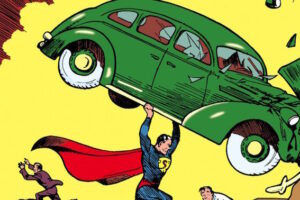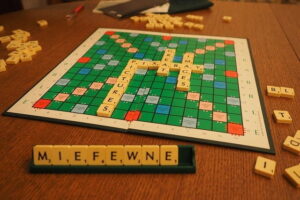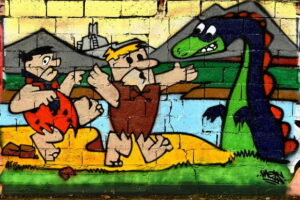10 Strange and Forgotten Beds from Around the World
When considering the evolution of beds, it may seem that little has changed over the years. While there are indeed high-tech levitating beds designed for the ultra-wealthy, for the most part, beds have remained relatively unchanged for millennia. After all, how much innovation can be applied to a flat surface intended for sleep without compromising its fundamental purpose? However, this perception should not overshadow the fact that bed design has experienced numerous peculiar, unconventional, and even bizarre developments throughout history. From impractical designs to those that defy logic, here are ten unusual bed designs that time has mercifully left behind.
For example, did you know that in the 19th century, some beds were engineered to serve dual purposes as exercise equipment? Or that there were beds shaped like colossal seashells, intended to evoke the sensation of sleeping underwater? Although these eccentric creations did not endure, they provide intriguing insights into the past. Some represented attempts to merge functionality with artistry, while others were simply experimental designs that failed to meet practical standards.
What is truly fascinating is how these designs reflect the priorities and creative visions of their respective eras. A bed is not merely a place for rest; it is also a medium for artistic expression, even when such creativity leads to perplexing outcomes. Whether it is a rotating bed, one that folds into a wall, or a design resembling something from a science fiction film, these forgotten innovations remind us that progress is not always about practicality. Sometimes, it involves challenging boundaries, even if the result is more amusing than functional.
Thus, if you have ever considered beds to be mundane, reconsider. The history of bed design is replete with quirky, unexpected, and occasionally humorous ideas that demonstrate even the most ordinary objects can possess extraordinary narratives. Whether you are a history aficionado, a design enthusiast, or simply someone who appreciates a good “what were they thinking?” moment, these overlooked bed designs are certain to entertain and inspire. After all, who knows? Perhaps one of these unconventional concepts will experience a resurgence—stranger phenomena have occurred!
10.The Great Bed of Ware
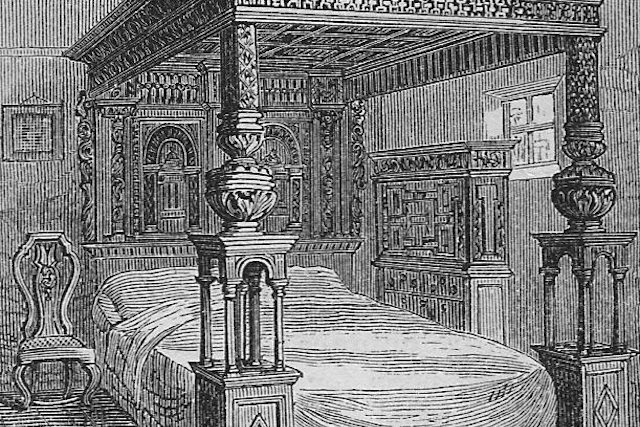
The Great Bed of Ware is one of those fascinating historical oddities that feels almost too strange to be true—yet it’s very real. Imagine a bed so massive it could comfortably sleep more than four couples at once! Built around 1590, this colossal four-poster bed stretches over three meters wide and stands at an impressive 2.67 meters tall. To put that into perspective, it’s taller than most modern bedrooms. Its sheer size made it a pop culture sensation even back in the day, earning mentions in works by Shakespeare and Ben Jonson. In Twelfth Night, Shakespeare’s character Sir Toby Belch jokes about a piece of paper being “big enough for the [Great] Bed of Ware,” proving just how iconic this bed was even in its time.
The bed gets its name from Ware, a small town in Hertfordshire, England, which was a popular rest stop for travelers shuttling between Cambridge and London. Over the years, countless guests who spent the night in this bed left their mark—literally. Many carved their initials into the wood or pressed their seals into red wax, turning the bed into a kind of historical guestbook. Today, these marks are part of its charm, adding a layer of personal history to an already remarkable piece.
Now housed at London’s Victoria and Albert Museum (V&A), the Great Bed of Ware is a masterpiece of Elizabethan craftsmanship. Its intricate carvings feature Renaissance motifs like acanthus leaves, lions, satyrs, and even painted figures. It’s a stunning blend of artistry and functionality, though it’s hard to imagine anyone actually using it for a good night’s sleep these days. The bed has had quite the journey, moving between five different inns before ending up in a fortified manor, where it was largely forgotten until the V&A acquired it in 1931 for £4,000—a hefty sum equivalent to around £340,000 today. In 2012, it even made a brief return to Ware, requiring cranes to transport it!
What makes the Great Bed of Ware so captivating isn’t just its size or craftsmanship—it’s the stories it carries. From Shakespearean references to the countless travelers who left their mark, it’s a tangible piece of history that feels both grand and oddly personal. It’s the kind of artifact that makes you wonder: who slept here? What were their stories? And how did a bed become such a cultural icon? If you’re ever in London, it’s definitely worth a visit—just don’t expect to take a nap in it!
9.The box bed
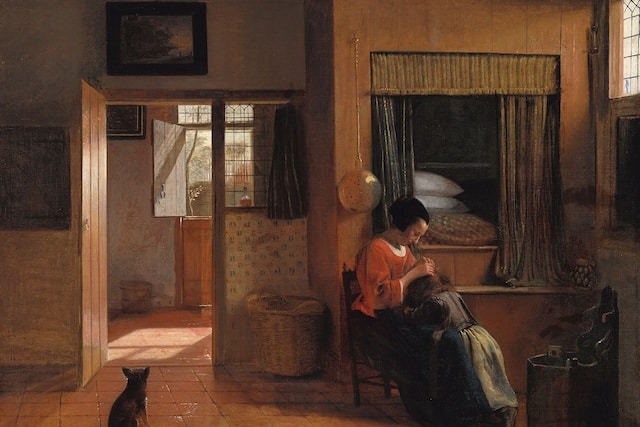
The box bed, or lit clos, resembled a cupboard. It was basically a wooden box with a bed inside that was popular 600 years ago—for some highly practical reasons. For one thing, it afforded sleepers privacy and space at a time when families lived in cramped single rooms. It also retained warmth in harsh winters. More importantly, though, it protected sleepers from intrusion by wild animals—wolves, bears, and so on—or even just livestock wandering through (the origin of counting sheep?).
It was used throughout Europe from the Middle Ages to the 1800s. So its design varied widely from simple wooden boxes to objets d’art with elaborately carved, painted, or paneled sides. Some had curtains, prioritizing privacy, while others had doors (often sliding doors) to prioritize safety from animals. Most were also raised off the ground, allowing for storage beneath.
8.Dr. Graham’s Celestial Bed
James Graham, a self-proclaimed “doctor” from Scotland, never actually finished medical school, but that didn’t stop him from becoming one of the most bizarre figures of the 18th century. After spending five years in America, where he became fascinated by Benjamin Franklin’s experiments with electricity, Graham became convinced that electricity held the key to healing—especially when it came to boosting sexual vitality. He saw it as a miracle cure, and he wasn’t shy about selling that idea to anyone who would listen.
In 1780, Graham opened his infamous Temple of Health in London’s Adelphi Terrace. The place was a sensory overload: perfumed air, mood lighting, and dramatic electrical displays featuring sparks and flashes from Leyden jars. But the real star of the show was the Celestial Bed, a massive, three-meter-wide, four-meter-long contraption designed to combine pseudoscience with a hefty dose of erotic appeal. The bed was surrounded by magnets and other gadgets, all supposedly designed to increase the chances of conception—and, of course, maximize sexual pleasure, which Graham claimed was essential for producing healthy children.
The bed itself was stuffed with stallion tail hair and oats (yes, oats), and the atmosphere was enhanced with music and carefully curated lighting. To top it all off, there was a giant mirror on the ceiling and a biblical inscription on the headboard: “Be fruitful. Multiply and Replenish the Earth.” Couples paid a small fortune—anywhere from 50 guineas to 100 pounds—for a single night in this bizarre creation.
For a while, Graham’s Temple of Health was a sensation. People flocked to experience his electrifying promises of vitality and fertility. But as time went on, the public began to see through the charade. Facing mounting debts and growing skepticism, Graham eventually fled London for Edinburgh. His later years were no less eccentric: after a stint in jail for indecency, he pivoted to promoting mud baths as the ultimate path to immortality.
James Graham’s story is a wild mix of ambition, pseudoscience, and sheer audacity. His Celestial Bed remains one of history’s most peculiar inventions, a testament to the lengths people will go to chase the promise of health, pleasure, and eternal life. It’s a tale that’s equal parts fascinating and absurd—perfect for anyone who loves a good historical oddity.
7.Thomas Jefferson’s alcove bed

Thomas Jefferson’s alcove bed at Monticello was literally built into the wall between rooms—namely his bedroom and his study. This way, he had easy access to both.
Of course, it also gave him easy access from both—which was useful for keeping to his strict routine of getting up early and sleeping in the evening.
This was also the bed he died in, on July 4, 1826, 50 years to the day after the Declaration of Independence was adopted.
6.Self-making bed

The fairly ludicrous concept of a self-making bed appears in several patents. One, from the 1980s, involves a system of arms and rollers to smooth down the covers after use. According to the inventor, the arms are mounted onto the bed frame and use rotating wheels and helical screw rollers to stretch and flatten bedspreads from the center to the edges. Proceeding from the foot of the bed to the head, they serve to smooth and secure the covers in place.
Powered by an electric motor connected to a drive shaft, these somewhat terrifying arms were specially designed to avoid messing up the sheets in returning to their start point. It’s not exactly clear if the bed was ever made but it’s hard to imagine it would have caught on.
Even so, there is something similar on the market today. Instead of mechanical arms, Smartduvet’s inflatable layer just under the cover lifts and smooths out the wrinkles.
5.Two-penny hangover
In the 19th century, England’s industrialization gave rise to a surge in population, leading to a homelessness crisis (or a golden age of vagabonds, depending on how you look at it). The answer from charities in London was a range of simple beds for the destitute—among which was the “two-penny hangover”.
Basically, this was a communal sleeping arrangement where tramps paid tuppence to sit on a bench and lean over a rope strung from one side of a room to the other. Although it provided support throughout the night—and some security, by virtue of being indoors—it wasn’t the most comfortable solution. Not only were sleepers crammed in together but, at dawn, the rope was simply dropped to the floor, waking the sleepers to shove them out the door. Fittingly, the two-penny hangover is one possible origin of the relatively modern term “hangover,” as in the after-effects of getting wasted. (Incidentally, the phrase “sleep tight” comes from a medieval rope bed that had to be tightened every so often to support a mattress.)
Another sleeping arrangement for tramps, aimed at the more discerning and well-to-do vagrant, was the “fourpenny coffin”. Despite the macabre shape, these wooden boxes at least afforded tramps a horizontal sleep. They also came with a very simple covering.
4.Piano bed

In the 19th and early 20th centuries in America, the piano was a must-have piece of furniture. Even if no one ever played it, it became a status symbol for the parlor.
Of course, it also had a big footprint, like a bed—which explains why some chose to combine them. Smith & Co.’s 1885 “Convertible Bed in Form of Upright Piano” didn’t actually work as a piano; it just looked like one. Inside, a fold-out wooden bed frame left no space for hammers and strings—let alone acoustics.
An earlier patent, from one John McDonald of New York, in 1869, described a “keyboard musical instrument … that … may be opened up to serve as a bed and which, when closed, shall have every appearance of and may in fact be a real instrument.”
3.Rotating bed

What if your bed was like a giant lazy susan? First introduced in 1968, the rotating bed was designed by Luigi Massoni (and later immortalized by the spy Austin Powers). It had a circular mattress that could be rotated in either direction on wheels built into the base.
The rotating bed also appeared in Hugh Hefner’s Playboy Mansion, where it was something of a centerpiece. Quaintly, his featured a built-in telephone and stereo system.
Although rotating beds are still on the market, they’ll forever be a throwback as a concept.
2.Arcuccio co-sleeper

As the parent of a baby, you can say goodbye to sleep. If you’re not waking up to deal with its screams, you’re worried because you’re not hearing any. But you can’t just sleep with the baby in your bed because of the risk of suffocation and overheating.
It was to address this problem that, in the 17th century, the arcuccio co-sleeper was designed. Here was a baby bed that allowed mothers to breastfeed without getting up, or, in theory, even waking up. It was kind of like a wooden cage for the baby, designed to be placed right on the bed with its mother. The key innovation was a cutout for her breast, giving babies easy and intuitive access, while also preventing suffocation by keeping the bulk of the mother’s body, as well as the bedclothes, at bay.
It became so well known in Florence that its use was practically mandatory.
1.Baby cage
In the early 20th century, a peculiar parenting trend took hold in urban areas: baby cages. Yes, you read that right—cages for babies, suspended outside apartment windows several stories up. The idea might sound shocking today, but back then, it was seen as a modern solution for city-dwelling families who lacked access to gardens or outdoor spaces. The trend gained traction after a prominent pediatrician claimed that children who slept outdoors grew up stronger and healthier. For parents in cramped apartments, these “window cribs” or “health cages” became a way to give their babies a taste of fresh air without leaving home.
One of the most famous advocates of the baby cage was none other than Eleanor Roosevelt. She hung one outside her window for her daughter, believing she was embracing the latest in child-rearing innovation. However, not everyone shared her enthusiasm. One of her neighbors was so horrified by the sight of a baby in a cage dangling from a window that they threatened to report her. Roosevelt later reflected on the incident, admitting she was shocked by the reaction. She had genuinely thought she was being “a most modern mother.”
The baby cage was essentially a birdcage-like contraption designed to attach securely to a window frame. It allowed infants to nap outdoors, soaking up the supposed benefits of fresh air and sunlight. While the idea might seem bizarre—and even dangerous—by today’s standards, it was a product of its time, reflecting the era’s fascination with health and hygiene.
Despite its brief popularity, the baby cage didn’t stand the test of time. Concerns about safety, practicality, and changing attitudes toward child-rearing eventually led to its decline. Today, the concept of suspending a baby in a cage outside a window feels almost unthinkable, but it remains a fascinating glimpse into the quirks of early 20th-century parenting. It’s a reminder that what’s considered “modern” or “innovative” in one era can quickly become a curious relic of the past.
So, the next time you see a baby stroller or a playpen, just imagine how different things might have been if the baby cage had stuck around. It’s one of those strange historical tidbits that makes you wonder: what parenting trends of today will future generations look back on and shake their heads at?



